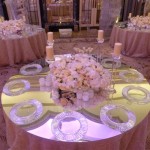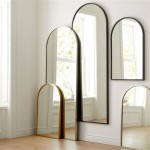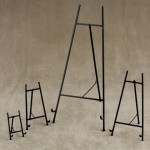Can A TV Be A Mirror? Exploring the Technology and Practicality
The concept of a television that doubles as a mirror has moved from science fiction to reality. These innovative devices, often called mirror TVs or mirrored televisions, are gaining popularity for their ability to seamlessly blend technology with interior design. However, the question of whether a TV can truly function as a mirror requires a detailed examination of the underlying technology, practical limitations, and user experience.
At its core, a mirror TV operates by integrating a standard LCD or LED television screen behind a specialized two-way mirror. This mirror is designed to reflect light when the TV is off, creating a mirror-like surface. When the television is powered on, the light emitted from the screen penetrates the semi-transparent mirror, allowing the image to be visible. The quality of the mirror effect and the clarity of the TV image are dependent on a number of factors, including the type of mirror coating, the brightness of the television, and the ambient lighting conditions.
The appeal of a mirror TV stems from its dual functionality. In a bathroom, bedroom, or living room, it can serve as a regular mirror for personal grooming, checking attire, or simply reflecting the room. When entertainment or information is desired, the television function can be activated, providing access to streaming services, cable channels, or other media sources. This versatility makes mirror TVs an attractive option for maximizing space and minimizing visual clutter.
Understanding the Underlying Technology
The key to the functionality of a mirror TV lies in the specific type of mirror used. Unlike standard mirrors, which are designed to reflect nearly all light, a two-way mirror possesses a semi-transparent coating. This coating allows a portion of the light to pass through the mirror while reflecting the remainder. The ratio of light transmission to reflection is carefully calibrated to achieve the desired balance between mirror reflectivity and screen visibility.
The coating typically consists of a thin layer of metal, such as aluminum or silver, applied to a glass substrate. The thickness of this layer is crucial; too much metal will result in a highly reflective surface but will significantly diminish the visibility of the television screen. Conversely, too little metal will allow too much light to pass through, reducing the mirror's reflectivity and making it appear more like a tinted window.
The brightness of the television screen is another critical factor. To ensure a clear and vibrant image through the two-way mirror, the television must be capable of producing a high level of brightness. This is typically measured in nits (candelas per square meter). A television with a higher nit rating will be more effective at overcoming the reflectivity of the mirror and producing a visible image, particularly in brightly lit environments. For optimal performance, mirror TVs often utilize high-brightness LED or LCD panels.
The contrast ratio of the television also plays a role in image quality. A high contrast ratio, meaning a large difference between the brightest and darkest areas of the image, contributes to a clearer and more detailed picture. This is especially important when viewing content with subtle shades and gradations, as a low contrast ratio can result in a washed-out or unclear image when viewed through the mirror.
Factors Affecting Mirror and Television Performance
Several environmental factors can influence the effectiveness of a mirror TV. Ambient lighting is perhaps the most significant. In a brightly lit room, the mirror effect will be more pronounced, and the television image may appear less vibrant. This is because the ambient light is competing with the light emitted from the television screen. Conversely, in a dimly lit room, the television image will be more prominent, and the mirror effect will be less noticeable.
The viewing angle also affects the perceived image quality and mirror reflectivity. When viewed from a sharp angle, the mirror effect may become more distorted, and the television image may appear darker or less clear. This is due to the properties of the two-way mirror coating and the limitations of LCD and LED screen technology. Viewing the mirror TV from a perpendicular or near-perpendicular angle typically yields the best results.
The quality of the installation can also impact the overall performance. Proper mounting and alignment of the television and mirror are essential to ensure a seamless and aesthetically pleasing appearance. Misalignment can result in uneven gaps or distortions in the reflected image, detracting from the overall effect. Professional installation is often recommended to ensure optimal performance and long-term reliability.
Furthermore, the color temperature of the television screen can influence the perceived color accuracy of the reflected image. If the television screen is calibrated to a cool color temperature (bluish tones), the reflected image may appear slightly cooler than it would on a standard mirror. Similarly, a warm color temperature (yellowish tones) can impart a warmer hue to the reflected image. Adjusting the television's color settings can help to mitigate these effects and achieve a more natural-looking reflection.
Practical Applications and Limitations
Mirror TVs have found applications in a variety of settings, including residential homes, hotels, spas, and retail environments. In bathrooms, they can be seamlessly integrated into vanity mirrors, providing a convenient way to watch television while getting ready. In bedrooms, they can be used as decorative accents or to conceal the television when not in use. In retail environments, they can be used to display promotional videos or interactive advertisements.
Despite their advantages, mirror TVs also have some limitations. The cost of mirror TVs is generally higher than that of standard televisions, due to the specialized mirror coating and the more complex manufacturing process. The image quality of a mirror TV may not be quite as good as that of a standard television, particularly in brightly lit environments. The reliance on a two-way mirror necessitates a trade-off between mirror reflectivity and screen visibility, which can impact the overall viewing experience.
Another limitation is the potential for glare. The reflective surface of the mirror can sometimes cause glare, particularly from overhead lighting or sunlight. This glare can make it difficult to see the television image clearly. Choosing a location with diffused lighting and utilizing anti-glare coatings on the mirror can help to minimize this issue.
Finally, the depth of the installation can be a concern. Mirror TVs typically require more depth than standard televisions, due to the need to accommodate the television screen behind the mirror. This can be a factor in situations where space is limited. Careful planning and consideration of the available space are essential when installing a mirror TV.
In conclusion, while a TV can indeed be a mirror, the effectiveness of this dual functionality depends on a careful balance of technology, environmental factors, and user expectations. The quality of the two-way mirror, the brightness and contrast of the television screen, the ambient lighting conditions, and the viewing angle all play critical roles in determining the overall performance. While mirror TVs offer a unique combination of aesthetics and functionality, potential buyers should carefully consider their specific needs and limitations before making a purchase.

How To Turn Your Tv Into A Mirror Pro Display

Mirror Tv How It Works Joseph Mccarthy Mirrors

How To Turn Your Tv Into A Mirror Pro Display

How To Turn Your Tv Into A Mirror Pro Display

Magic Televisions Multifunctional For A Large Or Small House

Automated Tv Mirror

Bathroom Mirror Tvs From Techvision Tv In Disguise

2024 Tutorial How To Mirror Phone Tv Without Wi Fi

21 5 Inch Touch Screen Mirror Ip66 Waterproof Tv For Bathroom Shower Support 360 Rotation 500 Nits High Brightness Full Hd 1080p Led Built In Android 11 0 Leosmjmg 215 Leotachi

How To Screen Mirror Your Iphone A Roku Tv Otech








